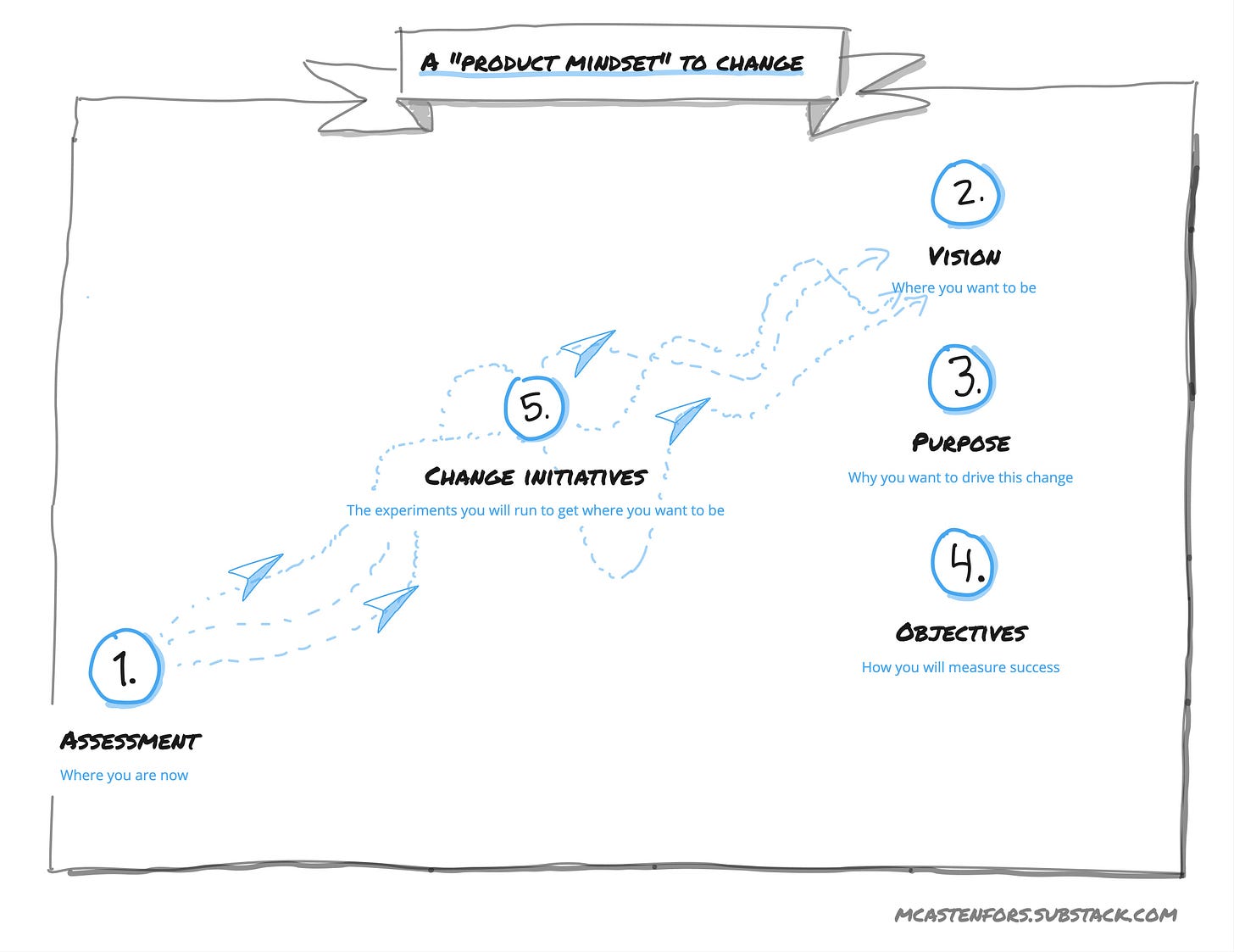Anti-pattern #9: Leaders not talking enough about the “why”
Without a concise message, confusion takes hold.
Note: this is the ninth article in the series on anti-patterns when moving to the product model. Here’s the first anti-pattern: "Giving too much autonomy, too soon".
Imagine this: The room is packed.
You’re at the start of a major transformation. The foundation seems solid. Leadership is bought in, and momentum is building.
Dozens of eager faces are watching you, waiting for answers. The company is at a critical turning point, and this panel discussion is meant to inspire confidence in the bold new direction.
The panel introduces themselves. Questions start flowing. The moderator kicks things off, and the audience joins in. There are nods, laughter, and a sense of engagement. Then, a hand goes up.
One of the audience members—a known Doubter—directs their question to a panelist:
“This all sounds interesting, but—why—are we doing this? Why is moving to this new operating model better for the company?”
Time seems to stand still. The room goes silent. You can feel the energy shift.
The panelist hesitates, grows visibly uncomfortable, and finally says:
“Um, I don’t know….”
In that moment, the momentum is lost.
Doubt spreads like wildfire. It doesn’t matter what’s said next—the room has already slipped away.
In an instant, many Believers become Doubters.
Alright.
Let’s pause here.
A question to you, the reader: What happened in that conference room that day?
The short answer: the room was lost.
And what do you think happens next? The stories from that meeting ripple across the organization. People talk. Doubt spreads. And the transformation? It faces an uphill battle to get back on track.
And, why did this happen?
The panel had no succinct story to explain why the company was embarking on this change journey. No clear purpose was articulated. Without that, it all just seemed like “busy work.”
This story highlights an anti-pattern my colleagues and I have encountered countless times: there’s no clear, simple, and compelling story to explain WHY the change matters.
Without a concise message, confusion takes hold, misalignment follows and progress ultimately stalls.
Again, a question for you:
What would you say is the main role as a driver of change?
I’d argue it’s this:
To win the hearts and minds of the organization by showing that this change is worth investing in.
That starts with clearly articulating:
Why this transformation matters.
Where you’re heading.
How you’ll measure progress along the way.
Let’s explore how to do just that, and more.
How to avoid this anti-pattern
In the following sections, you’ll find a proven framework I’ve successfully used to help companies transition to the product model and establish a structured system for change. This framework connects the big picture to the small picture—from crafting a transformation vision to defining change initiatives, supported by a governance structure to sustain progress.
As discussed in the previous anti-pattern, “Going ‘all in’ at the same time,” driving a successful change journey requires applying a product mindset. Approaching change, just as in product development, this means:
Understanding your current state: To make informed decisions about where to focus.
Having a clear direction: A vision and purpose behind the change.
Setting objectives and criteria to measure success: So you can track progress and know whether you’re moving in the right direction.
Ready to get started? Let’s dive in.
1. Assess your current situation
First things first. This step lays the foundation for your transformation by helping you understand where you stand and identifying the fundamental problems you need to solve. Think of it as applying the same approach you would with a product team—gathering insights from users, the market, stakeholders, and your technology capabilities—but with an internal focus on the challenges preventing your organization from delivering value faster and bringing more innovative products to market.
How to do it:
Gather insights: Collect perspectives from stakeholders, customers, the competitive landscape, and other relevant data sources.
Conduct interviews: Speak to around 20 people across the organization. Focus on uncovering pain points, leadership styles, communication gaps, and cultural dynamics.
Facilitate a value stream mapping workshop: Use this to identify bottlenecks and inefficiencies in the flow of work, from upstream to downstream activities.
Outcome:
Translate insights into concise, actionable recommendations that directly guide and shape your change efforts.
2. Define the transformation vision
With the problems identified, the next step is to paint a compelling picture of where you’re headed. Just as in product development, you need to define a clear direction that aligns and inspires. The goal is to craft a vision that resonates emotionally, showing everyone that this change is both meaningful and worthwhile.
How to do it:
Workshop with senior leadership to define a clear, shared vision. Focus on tangible outcomes that everyone can rally behind. The story of the future should illustrate how you’ve transformed the way you build, solve problems, and decide which problems to solve.
👉 Marty Cagan’s perspective on transformation
Example exercise:
Start with the end in mind.
Imagine it’s [insert future date].
The CEO sends an email to the entire company, celebrating the transformation’s success.
Ask the room:
What’s featured in the email?
What obstacles were overcome?
How have employees, teams, and customers benefited?
Outcome:
Align leadership on specific, inspiring outcomes while painting a vivid picture of the future.
3. Describe the purpose
To avoid the scenario from the beginning, it’s time to define the why—why this transformation is happening and why people should care. Your goal is to craft a short, compelling message that aligns the entire organization and gives people a reason to invest their time and energy in changing the way they work.
This message should serve as a mantra, something that is repeated often and woven into everyday conversations—from all-hands meetings and leadership updates to internal emails and casual discussions. The goal is simple: everyone in the organization should understand why this change is happening and why it matters.
How to do it:
Example exercise:
Review the CEO’s email from the vision exercise.
Identify key themes that reflect the transformation’s core focus.
Distill the message into one memorable sentence that’s simple, clear, and meaningful.
Examples of transformation purposes:
Simpler, faster, better.
Focus on what matters, together.
Outcome:
Create a purpose statement that inspires, aligns, and resonates across the organization. When people hear it, they should immediately understand the transformation’s essence.
4. Create transformation objectives
How will you measure progress toward your vision and purpose? Too often, transformations turn into “busy work” with no clear way to tell if you’re moving in the right direction. Why does this happen? Because measuring a transformation is hard—it’s abstract. How do you quantify becoming more innovative?
The good news: there’s always a way. It might not be perfect at first, but having measures of progress is essential. Just as OKRs create alignment in product development, use the OKR framework to define transformation objectives to gauge progress.
How to do it:
Define no more than three transformation objectives that address the most critical problems to solve. These objectives should act as guiding beacons to focus your efforts.
Here’s an example:
Example exercise:
Revisit the insights, vision and purpose.
Identify the top 3 problems to solve in the next 12 months.
Set success criteria for each problem, such as:
eNPS (employee Net Promoter Score): Measure team engagement and satisfaction.
Lead time: Track how quickly teams move from discovery to delivery to value.
Number of escalations: Reduce the number of issues requiring leadership intervention.
Number of incidents: Monitor and minimize product stability issues.
Survey question: “Do you understand BigCo’s strategic context?” Measure clarity of direction.
Number of experiments: Increase the number of validated product experiments.
Outcome:
Ensure your transformation efforts stay focused while creating alignment on what truly matters.
5. Launch change initiatives
Once you’ve defined the vision, purpose, and objectives, the next step is to identify and prioritize specific initiatives that address the key problems uncovered in your assessment. Applying a product mindset to your transformation means treating every step toward your transformation vision as an experiment—an opportunity to test, learn, and refine.
The importance of quick wins
A critical question to ask early on: what change initiatives will create the most impact in the short term?
Having led many transformations, one pattern consistently stands out—the power of quick wins. As mentioned earlier in this series, early wins build momentum. They serve as case studies, providing tangible evidence that the new way of working is making a real difference.
If progress slows, so does the transformation.
Examples of quick-win initiatives:
Coaching a product team to launch a simple experiment within two weeks.
Launching a webinar series to educate the organization on the core components of the product model, ensuring broad reach.
Collaborating with product leaders to define an updated, focused product strategy.
Measuring effectiveness
For every initiative, define how you will measure success. What signals will indicate that the change is making an impact? Just like in product development, you need feedback loops to track whether the initiative is working—or if adjustments are needed.
To give you some inspiration, here are some examples of change initiatives and how to measure their impact:
💡Visualization tip
When driving change, use a simple initiative board to track progress. This serves as a lightweight roadmap that fosters alignment and transparency across the organization.
The change leadership team
Now that you have an initiative board with identified first initiatives, the next step is to establish a cross-functional leadership team to govern the transformation. This should be a small group of senior leaders—typically three to four—who are invested in driving change. These leaders must have "skin in the game" and a strong commitment to ensuring progress. The team should meet bi-weekly to go through the status of initiatives, remove roadblocks, and steward the change.
Their role:
Ensure steady progress toward transformation objectives.
Prioritize the most critical problems to solve and the initiatives that address them.
Sequence initiatives over time and assign clear ownership.
Create the right conditions for success by providing teams with the necessary support.
For the initial session, consider a workshop or discussion focused on the role of each change leader and the collective purpose of the leadership team. The goal is to ensure buy-in and commitment so leaders actively invest their time and energy in making the transformation a success.
To maintain focus, limit the number of active initiatives to a maximum of three at any given time. Each initiative should have a dedicated “Lead”—someone responsible for guiding it forward. This doesn’t mean they do all the work themselves, but they ensure alignment, progress, and learning.
Getting started often comes with a burst of energy, but the real challenge is sustaining momentum beyond the first few meetings. That’s why the team itself is just as important as its mission. Build the team to build the change. A strong change leadership team—grounded in trust and a shared commitment—will set you up for success.
Key takeaways
Without a clear and compelling why, confusion spreads, momentum stalls, and change efforts lose traction. To drive meaningful transformation, assess your current state, define a vision, articulate a strong purpose, set measurable objectives, and launch focused change initiatives. A committed change leadership team is essential to maintaining alignment, learning, and progress.
What’s next
In the final anti-pattern of this series, we’ll explore “Leaders talk the talk but don’t walk the walk”—when leaders pay lip service to the transformation and fail to take real action. We’ll break down why this is such a dangerous pitfall and how to avoid it. Stay tuned.












